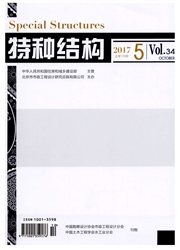

 中文摘要:
中文摘要:
强风作用是输电塔等高耸结构倒塌的潜在威胁,由于不同风场的特征存在很大的差异,导致结构具有不同的破坏形式。本文研究了两种风场下结构不同高度截面抗风能力的验证方法。文中,首先引入了边界层近地风和下击暴流风的设计风荷载;其次,提出了输电塔结构抗风能力的验证方法,即两种风力引起的输电塔结构底部截面弯矩相等,并在达到输电塔结构底部截面抗风能力极限状态时,计算不同高度处输电塔截面的抗风能力是否满足设计要求;最后以一大跨越输电塔为例进行分析,结果表明,当底部达到抗风能力极限状态时,下击暴流可导致结构在40m高度区域内发生破坏,而近地风可导致结构首先从根部发生破坏,从而在理论上验证了下击暴流强风荷载作用下输电塔结构大多不在根部首先发生破坏的现象。
 英文摘要:
英文摘要:
Strong wind is a significant threat to the safety of transmission tower. The difference between the downburst and boundary layer wind profiles will lead to transmission tower's different failure modes and damage regions. In this paper, downburst and boundary layer wind's design wind loads are proposed, and a novel analytical framework is formulated for checking the section wind-resistance capability under downbursts as well as under boundary layer wind loads. The bending moments on the bottom section of tower induced by downbursts and boundary layer wind loads are reached their wind-resistance capability, and the regions of damage and their heights along the tower under downbursts and boundary layer winds are determined and the corresponding wind-resistance capability are then calculated. It has been found that the peak values of the section moments exceed the ultimate section moment capability at about a third of the tower height under downbursts, while failure occurs in the bottom panel of the tower under boundary layer winds. The results of this investigation are consistent with the fact that the regions of damage for the most collapsed high-rise transmission towers under downbursts were indeed in the lower-middle height of the tower
 同期刊论文项目
同期刊论文项目
 同项目期刊论文
同项目期刊论文
 Calculation of eigenvalue and eigenvector derivatives with the improved Kron's substructuring method
Calculation of eigenvalue and eigenvector derivatives with the improved Kron's substructuring method Hydrogen sensing performance comparison of Pd layer and Pd/WO3 composite thin film coated on side-po
Hydrogen sensing performance comparison of Pd layer and Pd/WO3 composite thin film coated on side-po 期刊信息
期刊信息
